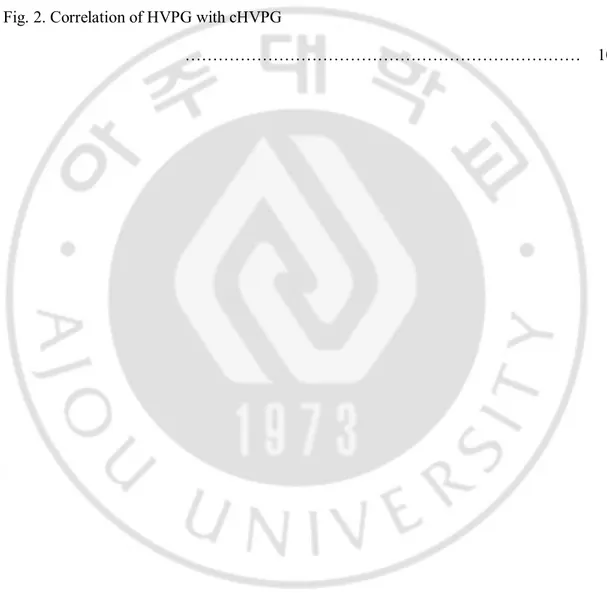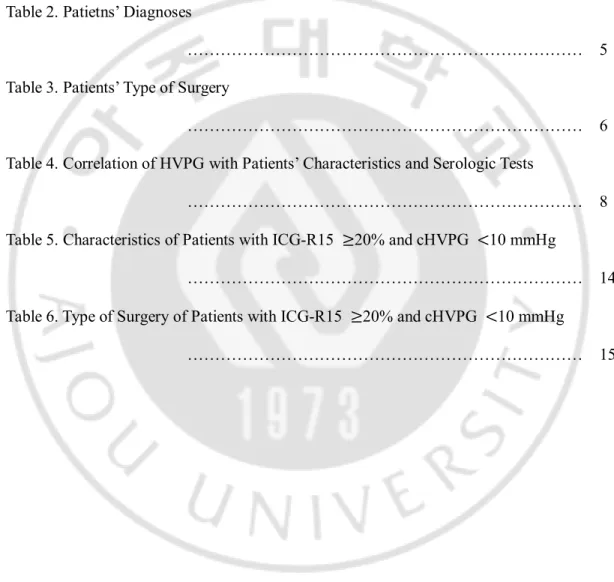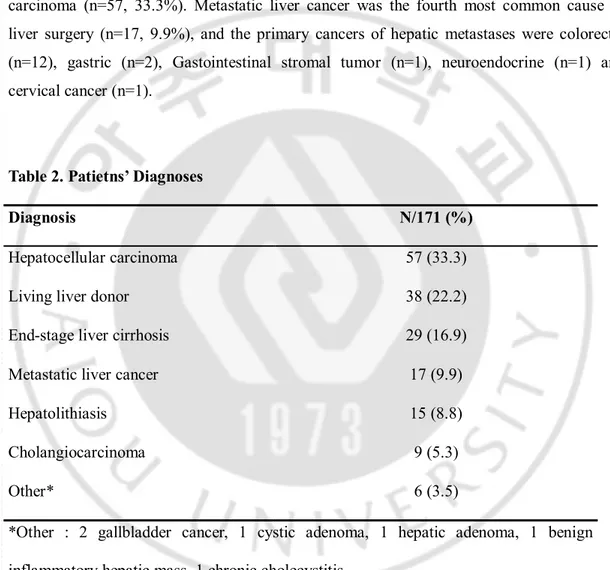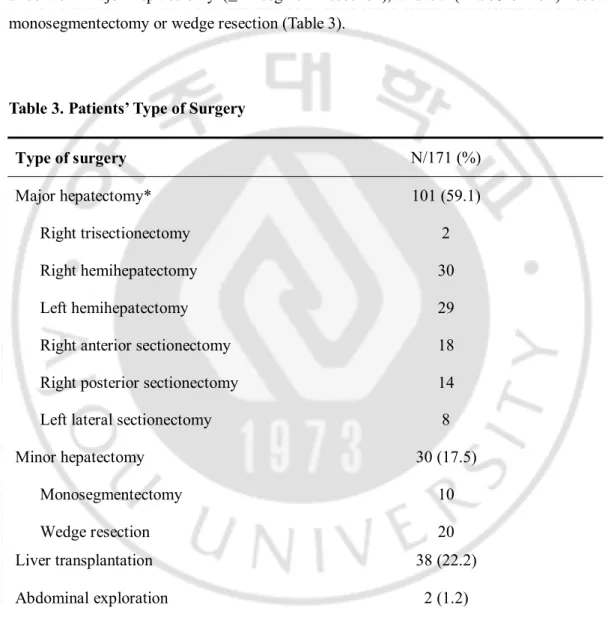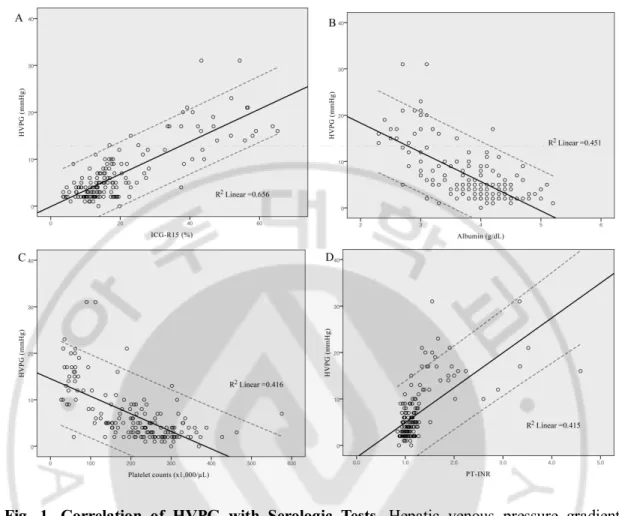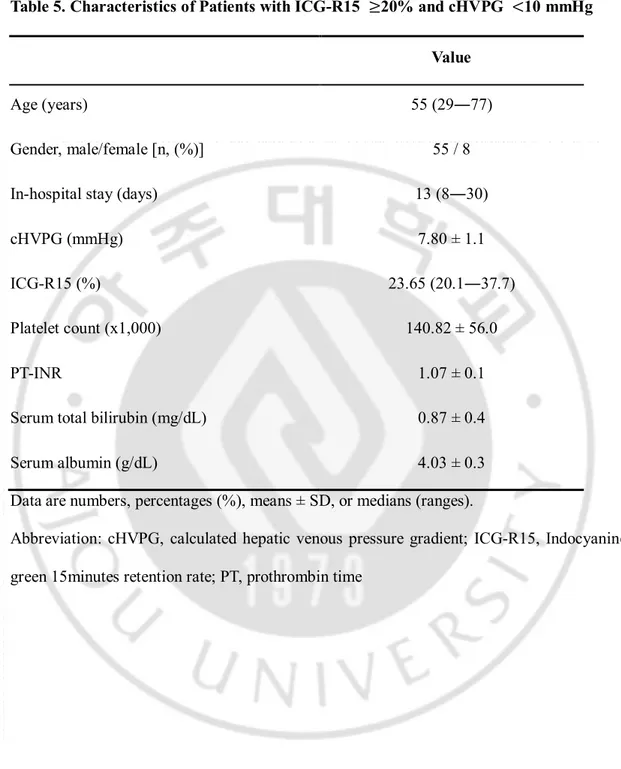저작자표시-비영리-변경금지 2.0 대한민국 이용자는 아래의 조건을 따르는 경우에 한하여 자유롭게 l 이 저작물을 복제, 배포, 전송, 전시, 공연 및 방송할 수 있습니다. 다음과 같은 조건을 따라야 합니다: l 귀하는, 이 저작물의 재이용이나 배포의 경우, 이 저작물에 적용된 이용허락조건 을 명확하게 나타내어야 합니다. l 저작권자로부터 별도의 허가를 받으면 이러한 조건들은 적용되지 않습니다. 저작권법에 따른 이용자의 권리는 위의 내용에 의하여 영향을 받지 않습니다. 이것은 이용허락규약(Legal Code)을 이해하기 쉽게 요약한 것입니다. Disclaimer 저작자표시. 귀하는 원저작자를 표시하여야 합니다. 비영리. 귀하는 이 저작물을 영리 목적으로 이용할 수 없습니다. 변경금지. 귀하는 이 저작물을 개작, 변형 또는 가공할 수 없습니다.
Assessment of portal pressure for liver surgery
using serologic liver function tests
by
Taegyu Kim
Major in Medicine
Department of Medical Sciences
The Graduate School, Ajou University
Assessment of portal pressure for liver surgery
using serologic liver function tests
by
Taegyu Kim
A Dissertation Submitted to The Graduate School of
Ajou University in Partial Fulfillment of The
Requirements for The Degree of
Master of Medicine
Supervised by
Bong-Wan Kim, M.D., Ph.D.
Major in Medicine
Department of Medical Sciences
The Graduate School, Ajou University
This certifies that the dissertation
of Taegyu Kim is approved.
SUPERVISORY COMMITTEE
Hee-Jung Wang
Bong-Wan Kim
Gyeong-Won Jeong
The Graduate School, Ajou University
June, 19th, 2015
i
- ABSTRACT -
Assessment of portal pressure for liver surgery using serologic liver
function tests
The preoperative assessment of portal pressure is important for selecting a treatment modality and ensuring safe liver surgery for hepatic malignancy. A hepatic venous pressure gradient (HVPG) of 10 mmHg is regarded as cutoff value for surgical decisions for safe hepatic surgery. However, this method may have procedure-related complications, and it is rarely performed in the East. This study was conducted with two aims: to determine calculated HVPG (cHVPG) using serologic test values and to evaluate the clinical reliability of cHVPG for surgical patients with limited liver function. For this purpose, 171 patients who had undergone hepatic surgery in a tertiary hospital between 2006 and 2008 were enrolled. For all 171, we performed simultaneous preoperative measurement of HVPG, a dye-retention test (Indocyanine green 15-minute retention test (ICG-R15)), complete blood cell counts, and routine chemistry. HVPG values were correlated with ICG-R15, platelet count, serum albumin, and prothrombin time (PT-INR) by multivariate analysis (P < 0.05). Using linear regression analysis, cHVPG was calculated by the following equation: cHVPG (mmHg) = 0.209 × ICG-R15 (%) − 1.646 × Albumin (g/dL) − 0.01 × Platelet counts (103) +
1.669 × PT-INR + 8.911 (Adj.R2=0.707). Between 2008 and 2013, 510 patients with
hepatocellular carcinoma were evaluated for surgery. Among them, 68 patients with ICG-R15 > 20% presented cHVPG values lower than 10mmHg. They received curative hepatectomy and recovered without major morbidity such as posthepatectomy liver failure. In conclusion, HVPG can be calculated by the equation using ICG-R15, platelet count, serum albumin, PT-INR, and serum total bilirubin. cHVPG could be a reliable alternative to HVPG for selecting the modality of liver surgery.
Keywords: Hepatic venous pressure gradient, Liver function tests, Portal hypertension, Hepatocellular carcinoma, Hepatectomy
ii
TABLE OF CONTENTS
ABASTRACT ……… i
TABLE OF CONTENTS ……… ii
LIST OF FIGURES .……… iii
LIST OF TABLES ……… iv
I. INTRODUCTION ………...… 1
II. PATIENTS AND METHODS ……… 2
A. Preoperative portal pressure assessments ……….. 2
B. Statistical analysis ……….. 3
III. RESULTS ………... 4
A. Reason for liver surgery ………..…... 5
B. Types of liver surgery ………..…... 6
C. Correlation of HVPG with serologic tests ………..…… 7
IV. DISCUSSION ……….…..……..… 10
V. CONCLUSION ………. 17
REFERENCES ……… 18
iii
LIST OF FIGURES
Fig. 1. Correlation of HVPG with Serologic Tests
……… 9 Fig. 2. Correlation of HVPG with cHVPG
iv
LIST OF TABLES
Table 1. Patients’ Preoperative Characteristics
……… 4 Table 2. Patietns’ Diagnoses
……… 5 Table 3. Patients’ Type of Surgery
……… 6 Table 4. Correlation of HVPG with Patients’ Characteristics and Serologic Tests
……… 8 Table 5. Characteristics of Patients with ICG-R15 ≥20% and cHVPG <10 mmHg
……… 14 Table 6. Type of Surgery of Patients with ICG-R15 ≥20% and cHVPG <10 mmHg
1
I. INTRODUCTION
Preoperative measurement of portal pressure is essential to the detection of subclinical portal hypertension. The accurate assessment of portal pressure in surgical patients for liver disease is important to prevent postoperative complications and to decide the extent of liver resection. There are many tests to measure portal pressure and hepatic venous pressure gradient (HVPG) is the best method of assessing portal pressure in liver cirrhosis. HVPG is measured by comparing free hepatic vein pressure and wedged hepatic vein pressure, and it is the most reproducible and reliable of the portal pressure assessments.(Groszmann et al., 2005; Ripoll et al., 2007) Despite the usefulness of HVPG, it has its drawbacks, as it requires an invasive procedure in patients with a high bleeding risk due to the hepatic disorder. HVPG measurement complications are uncommon and typically related to central venous punctures, such as bleeding, hematoma, neck pain, and Horner’s syndrome due to sympathetic nerve injury. Arrhythmia may be seen when the catheter or guide wire is moved in the right atrium. Noninvasive tests—dye retention test, laboratory tests (complete blood cell counts, serum bilirubin level, serum creatinine level, serum albumin level, and prothrombin time(PT-INR)) and radiologic findings (splenomegaly, ascites, and collateral vessels)— have also been commonly utilized. Indocyanin green 15-minute retention test (ICG-R15), one of the dye retention tests, is widely performed to measure portal pressure indirectly in the East.(Makuuchi et al., 1993; Llovet et al., 2003) However, results of these methods may be variable and inaccurate depending on various patients’ conditions (jaundice, genetic defection of ICG excretion, volume status). Moreover, these noninvasive methods cannot stratify subclinical portal hypertension precisely.(Llovet et al., 1999; Llovet et al., 2004)
In this study, we evaluated the accuracy and reliability of the portal pressure measurements by comparing them with HVPG and presented a new equation to calculate HVPG (cHVPG) using noninvasive tests. This cHVPG can predict subclinical portal hypertension more precisely and prevent postoperative complications.
2
II. PATIENTS AND METHODS
A total of 171 consecutive patients who had undergone liver surgery at Ajou University Hospital between January 2006 and December 2008 were included in this study. Patients with obstructive jaundice were excluded in this study. For all of them, we performed preoperative evaluation and measurement of portal pressure including HVPG, ICG-R15, complete blood cell count, and liver function test. These tests were done simultaneously within two days of liver surgery. All procedures and tests were performed with the informed consent of the patients and their legal guardians. The study was conducted after receiving approval of the institutional review board.
A. Preoperative portal pressure assessments
After overnight fasting, the patients were referred to the interventional radiologists who were exclusively responsible for the hepatic hemodynamic intervention. Under local anesthesia, a 6 Fr venous introducer was inserted in the right internal jugular vein by the ultrasonography-guided Seldinger technique. A 5 Fr ballooning catheter with pressure sensor (C2 Cobra catheter; Torcon NB® Advantage catheter, Cook Medical Inc.) was advanced via the introducer into the right hepatic vein under fluoroscopic control. The ballooning catheter was advanced into the right hepatic vein, and the catheter occluded the hepatic vein by ballooning. The wedged (occluded) and free hepatic venous pressures were checked after pressure was stabilized for 1 minute. After checking three times, the median value was recorded and HVPG was calculated by subtracting the free hepatic venous pressure from the wedged hepatic venous pressure.
ICG-R15 was used for the dye retention test. After overnight fasting, a bolus of Indocyanine green (ICG) with a dose of 0.5mg/kg was injected into the patients via the cephalic vein of one forearm. Fifteen minutes after the ICG injection, 8 mL of blood was sampled from the other forearm in a heparinized bottle. The injection of ICG and the blood sampling were conducted exclusively by a single technician. The concentration of ICG in the plasma was determined by spectrophotometry at 805 nm (Libra S12 spectrophotometer, Bichrom Ltd.). The ICG-R15 value was expressed as the percentage retention at 15 minutes.
3
Other laboratory tests were also performed. Complete blood cell counts, serum electrolytes level, serum bilirubin level, serum albumin level, liver enzyme levels, serum creatinine level, and PT-INR were checked. Platelet counts, serum total bilirubin, serum albumin, serum creatinine, and PT-INR, which are parts of Child-Pugh classification or MELD scoring system, were analyzed in this study.
B. Statistical analysis
Statistical analysis was performed using SPSS Statistics 13.0. Data were expressed as means or median values, ranges, and percentages. Univariate analysis was performed by the Student’s T test or Chi-square test. P values < 0.05 presented statistical significance. The correlation of HVPG with the parameters was calculated according to the linear regression equations. The reliability was determined by R-squared, which provided information about the goodness of fit of the model. In regression, R-squared, the coefficient of determination, is a statistical measure of how well the regression line approximates the real data points and ranges from 0 to 1. An R-squared value of 1 indicates that the model perfectly fits the data. The fitness of the regression model was validated by the residual plots and an ANOVA with F-statistics.
4
III. RESULTS
A total 171 consecutive patients who had received liver surgery at Ajou University Hospital were enrolled. Patients who had had cholestatic disease were excluded. There were 119 males (69.6%) and 52 females (30.4%) with a median age of 49 years. The patients’ characteristics are shown in Table 1. The mean value of HVPG was 6.7 mmHg, and that of ICG-R15 was 19.7%. The median length of in-hospital stay was 19 days (13-63days).
Table 1. Patients’ Preoperative Characteristics
Variables N = 171 Age (years) 49 (16―84) Sex, male/female [n,(%)] 119 (69.6%) / 52 (30.4%) Weight (Kg) 64.4 ± 9.9 Height (cm) 165.8 ± 7.8 BMI (Kg/m2) 23.4 (17.1―33.1) HVPG (mmHg) 6.72 ± 5.9 ICG-R15 (%) 19.69 ± 13.8
Prothrombin time, INR 1.24 ± 0.5
Platelet count, (x1,000/uL) 207.1 ± 100
Serum creatinine (mg/dL) 0.85 ± 0.2
Serum total bilirubin (mg/dL) 1.83 ± 4.4
Serum albumin (g/dL) 3.84 ± 0.6
5
A. Reason for liver surgery
The patients’ disease distribution is listed in Table 2. Among the 171 patients, 73 (42.7%) had HBV-related liver disease, 6 (3.5%) had alcoholic liver disease, 4 had HCV-related liver disease, and 4 had cryptogenic liver cirrhosis. Of 171 patients, 80 (46.8%) had biopsy-proven liver cirrhosis. The most common cause of liver surgery was hepatocellular carcinoma (n=57, 33.3%). Metastatic liver cancer was the fourth most common cause of liver surgery (n=17, 9.9%), and the primary cancers of hepatic metastases were colorectal (n=12), gastric (n=2), Gastointestinal stromal tumor (n=1), neuroendocrine (n=1) and cervical cancer (n=1).
Table 2. Patietns’ Diagnoses
Diagnosis N/171 (%)
Hepatocellular carcinoma 57 (33.3)
Living liver donor 38 (22.2)
End-stage liver cirrhosis 29 (16.9)
Metastatic liver cancer 17 (9.9)
Hepatolithiasis 15 (8.8)
Cholangiocarcinoma 9 (5.3)
Other* 6 (3.5)
*Other : 2 gallbladder cancer, 1 cystic adenoma, 1 hepatic adenoma, 1 benign inflammatory hepatic mass, 1 chronic cholecystitis
6
B. Types of liver surgery
Of the 171 patients, 131 underwent hepatectomy, 38 underwent live donor liver transplantation (LDLT), and 2 underwent abdominal exploration due to peritoneal carcinomatosis. Among the 131 patients who underwent hepatectomy, 101 (77.1% of 131) underwent major hepatectomy (≥ 2 segment resection), and 30 (22.9% of 131) received monosegmentectomy or wedge resection (Table 3).
Table 3. Patients’ Type of Surgery
Type of surgery N/171 (%)
Major hepatectomy* 101 (59.1)
Right trisectionectomy 2
Right hemihepatectomy 30
Left hemihepatectomy 29
Right anterior sectionectomy 18
Right posterior sectionectomy 14
Left lateral sectionectomy 8
Minor hepatectomy 30 (17.5)
Monosegmentectomy 10
Wedge resection 20
Liver transplantation 38 (22.2)
Abdominal exploration 2 (1.2)
7
C. Correlation of HVPG with serologic tests
In the univariate analysis ICG-R15, platelet count, PT-INR, serum total bilirubin, and serum albumin were significantly correlated with HVPG according to the cut-off value of HVPG of 10mmHg (Table 4). In the multivariate analysis, the relationship between serum total bilirubin level and HVPG was not significant (P = 0.652).
The mean ICG-R15 value was 19.7% ± 13.8 (range: 3.6-65.2%), the mean serum albumin value was 3.84 g/dL ± 0.62 (range: 2.3-5.2 g/dL), the mean platelet count value was 207,098 per μL ± 100,235 (range: 27,000-575,000 per μL), and the mean PT-INR value was 1.24 ± 0.5 (range: 0.84-4.59). The individual correlation of HVPG with ICG-R15, serum albumin, platelet count, and PT-INR by a linear regression analysis is shown in Figure 1. The coefficient of determination (R2 value) was expressed for each correlation.
HVPG (mmHg) = 0.53 × ICG-R15 (%) − 3.67. (R2 = 0.656)
HVPG (mmHg) = − 6.317 × Albumin (g/dL) + 30.947. (R2 = 0.451) HVPG (mmHg) = − 0.038 × Platelet counts (103) + 14.526. (R2 = 0.416)
HVPG (mmHg) = 7.507 × PT-INR –2.582. (R2 = 0.415)
The equations showed that ICG-R15 and PT-INR were directly correlated to HVPG, but platelet count and serum albumin level were inversely correlated. According to the R2 values
of the equations, ICG-R15 had the best reliable correlation with HVPG among the serologic tests (R2 = 0.656). According to the above equation of ICG-R15, 25.8% of ICG-R15 values corresponded to the value of 10 mmHg in terms of HVPG. In addition to the above equations, HVPG 10 mmHg was equivalent to 3.3 g/dL of serum albumin, 119,000 per μL of platelet count, and 1.67 of PT-INR. All four model assumptions were assessed by ANOVA test with F-statistics (P < 0.05).
By multivariate linear regression analysis, the cHVPG equation (K-equation) was established as follows:
cHVPG (mmHg) = 0.209 × ICG-R15 (%) − 1.646 × Albumin (g/dL) − 0.01 × Platelet counts (103) + 1.669 × PT-INR + 8.911. (R2 = 0.715, Adjusted R2=0.707)
8
The K-equation of the multivariate analysis using significant correlation factors had a relatively high coefficient of determination (0.707 of adjusted R2 value). The validity of the
K-equation was assessed by the residual plots and the ANOVA test (F = 98.278, P < 0.001). The correlation plots between HVPG and cHVPG are shown in Figure 2.
Table 4. Correlation of HVPG with Patients’ Characteristics and Serologic Tests
Variables HVPG <10mmHg (n = 129) HVPG ≥10mmHg (n = 42) Univariate analysis, P value Multivariate analysis, P value Age (years) 49 (16―84) 49 (36―69) 0.281 - Male sex [n (%)] 88 (68.75%) 31 (72.1%) 0.551 - Weight (Kg) 63.62 ± 9.2 66.98 ± 9.5 0.118 - Height (cm) 165.66 ± 7.5 166.14 ± 8.7 0.767 - BMI (Kg/m2) 23.1 (17.1―33.1) 24.1 (19.7―32.3) 0.068 - ICG-R15 (%) 13.93 ± 13.9 39.11 ± 15.0 < 0.001 < 0.001 Platelet count (x1,000) 241.18 ± 80.7 91.89 ± 72.4 < 0.001 0.003 PT-INR 1.06 ± 0.1 1.83 ± 0.7 < 0.001 0.014 Serum creatinine (mg/dL) 0.85 ± 0.1 0.83 ± 0.2 0.612 - BUN (mg/dL) 24.61 ± 17.2 26.10 ± 18.0 0.701 -
Serum total bilirubin
(mg/dL) 0.82 ± 0.3 5.24 ± 8.4 0.003 0.652 Serum albumin (g/dL) 4.04 ± 0.4 3.12 ± 0.5 < 0.001 0.004
Data are numbers, percentages (%), means ± SD, or medians (ranges). NOTE: Significance was defined as P < 0.05.
Abbreviation: BMI, body mass index; HVPG, hepatic venous pressure gradient; ICG-R15, Indocyanine green 15-minute retention rate; PT, prothrombin time
9
Fig. 1. Correlation of HVPG with Serologic Tests. Hepatic venous pressure gradient (HVPG) was significantly correlated with serologic tests of Indocyanine green 15-minute retention test (ICG-R15), serum albumin, platelet count, and prothrombin time (PT-INR) by multivariate analysis. Among them, the ICG-R15 had the most significant correlation with HVPG (R2=0.656). ICG-R15 (A) and PT-INR (D) were positively correlated to HVPG (P <
0.05), and serum albumin level (B) and platelet count (C) were inversely correlated to HVPG (P < 0.05). 95% prediction intervals are shown as dashed lines.
10
11
IV. DISCUSSION
The liver has various roles (e.g., detoxifying, synthetic, and excreting functions). Thus, evaluating the overall liver function requires a variety of examinations. In addition, the tests for predicting the remnant liver function after a liver resection are diverse due to the multiple functions of the liver. All of the liver function tests are limited in their ability to predict the prognosis of liver disease and the severity of hepatic disorder. Thus, we must apply many effective tests concurrently and analyze the results. Determining the interrelation among the liver function tests is necessary to assess actual liver function.
Portal pressure is a significant parameter for liver function. Portal hypertension refers to an abnormal increase in portal pressure, and it is defined by a portal pressure higher than 6 mmHg. The portal pressure cut-off value is 10 mmHg, whether compensated or decompensated liver cirrhosis.(Llovet et al., 2003; Llovet et al., 2004) The most reliable and reproducible measurement of portal pressure is HVPG.(Groszmann et al., 1990; Sanyal et al., 2008; Garcia-Tsao et al., 2010) If HVPG increases over 10mmHg, significant complications of liver cirrhosis, such as ascites and gastroesophageal varices, occur, indicating that liver cirrhosis has been decompensated. The most serious complications of portal hypertension, particularly bleeding of gastroesophagealvarices can occur over 12mmHg of HVPG. HVPG can stratify portal hypertension and predict its response to medical treatment. In spite of the merits of HVPG, it also has its drawbacks, as it requires an invasive procedure in patients with a high bleeding risk due to the hepatic disorder. Complications can occur, but they are uncommon.(Huet and Pomier-Layrargues, 2004; Bosch et al., 2009) Bleeding, hematoma, neck pain, Horner’s syndrome, and arrhythmia may be seen during the central venous puncture and when the guide wire is introduced into the right atrium. In our study, there were five cases of complications during the HVPG measurements. Four cases of bleeding and hematoma occurred, and one patient among these cases needed a transfusion of packed red blood cells. The other case suffered from Horner’s syndrome due to a sympathetic nerve injury during central venous catheterization.
Dye retention tests, especially ICG-R15 are widely performed to measure portal pressure indirectly in the East because of how convenient they are to conduct. The correlation of
ICG-12
R15 with the stiffness of liver in the operative field has been verified and it is important for predicting the hepatic reserve function. The increase of ICG-R15 in the cirrhotic liver results from the decrease of the transport of ICG to the liver due to the reduced hepatic flow in the systematic circulation and the decreased uptake in the hepatocytes from the liver sinusoid. An intrahepatic shunt reduces the virtual hepatic blood flow, and the sinusoidal capillarization impedes the free diffusion of high-molecular-weight proteins, like albumin, which transport substances of ICG. Consequently, the elimination of ICG would be delayed and the rise of ICG-R15 reflects the reduced hepatic function.(Jarnagin et al., 2012) In the case of ICG-R15 value over 20%, major hepatectomy is contraindicated, and liver cirrhosis is decompensated.(Makuuchi et al., 1993; Poon et al., 2002, 2004) However, the ICG clearance test remains imperfect, because it depends on both hepatic blood flow and the functional capacity of the liver. Test results may vary depending on patient’s cardiovascular status and serum bilirubin level.
Platelet count also reflects portal hypertension and is a risk factor related to the post-hepatectomy complication and mortality rates. In general, platelet count under 100,000/ul in the patients with the liver cirrhosis is not indicated for major hepatectomy.(Bruix et al., 1996) Serum albumin level and PT-INR are part of the Child-Pugh classification, which is used to predict mortality during the surgery and to determine the prognosis.(Child and Turcotte, 1964; Pugh et al., 1973) These parameters reflect the liver function but cannot stratify subclinical portal hypertension precisely.
The present study is the first report of a statistical analysis of the quantitative correlation between HVPG and the serologic tests for the assessment of portal hypertension. In this study, the quantitative correlations between HVPG and the serologic tests were derived by univariate and multivariate linear regression analysis of 171 surgical patients. The 171 surgical patients for the correlation analysis between HVPG and the serologic tests had various liver functions and histologies from live donor livers to end-stage liver disease.
Many previous studies have reported that the value of HVPG 10 mmHg could be a cutoff value of clinically relevant PHT in chronic liver disease, related to decompensated symptoms of liver cirrhosis.(Bruix et al., 1996; Llovet et al., 2003; Llovet et al., 2004; Boleslawski et al., 2012) Patients with decompensated liver cirrhosis may also present abnormal serologic test values, such as thrombocytopenia, hyperbilirubinemia, and
13
hypoalbuminemia. The multivariate regression analysis of this study showed that the value of HVPG was significantly correlated with ICG-R15, serum albumin, PT-INR, and platelet count. The serum level of total bilirubin was correlated with HVPG in the univariate analysis (P = 0.003) but had no significance in the multivariate regression (P = 0.65). However, it was unclear why the serum bilirubin level was only significant in the univariate analysis. Bilirubin alone is neither sensitive nor specific for intrinsic liver disease but serves as an indirect measure of the ability of the liver to take up and conjugate bilirubin and to secrete it eventually.(Jarnagin et al., 2012)
In our study, HVPG was significantly correlated with ICG-R15, platelet count, serum albumin, and PT-INR. With these parameters, we made the K-equation to calculate HVPG. We applied the K-equation in surgical patients who had received liver surgery between January 2009 and December 2013. There were 510 patients who had undergone liver surgery for hepatocellular carcinoma at Ajou University Hospital. With under 10mmHg of calculated HVPG, we could perform hepatectomy for 68 patients whose ICG-R15 levels over 20%, which is typically not acceptable for major hepatectomy (Table 5). Among the patients, 32 cases of major hepatectomy were performed. The other 36 patients underwent minor hepatectomy (Table 6). The median length of in-hospital stay was 13 days. There was no major morbidity or posthepatectomy liver failure. There was one case of in-hospital mortality on posthepatectomy day 29 due to Acinetobacter pneumonia. She was 69-years old and had underlying chronic obstructive pulmonary disease. The remaining 67 patients were discharged without any events and were followed in the outpatient clinic 1, 3, and 6-months later. After the 6-month follow-up, patients visited the outpatient clinic every 6 months until death. The median value of the follow-up period was 23.5 months (1-60), and 5-year survival rate determined by Kaplan―Meier analysis was 72.7%
14
Table 5. Characteristics of Patients with ICG-R15 ≥20% and cHVPG <10 mmHg Value
Age (years) 55 (29―77)
Gender, male/female [n, (%)] 55 / 8
In-hospital stay (days) 13 (8―30)
cHVPG (mmHg) 7.80 ± 1.1
ICG-R15 (%) 23.65 (20.1―37.7)
Platelet count (x1,000) 140.82 ± 56.0
PT-INR 1.07 ± 0.1
Serum total bilirubin (mg/dL) 0.87 ± 0.4
Serum albumin (g/dL) 4.03 ± 0.3
Data are numbers, percentages (%), means ± SD, or medians (ranges).
Abbreviation: cHVPG, calculated hepatic venous pressure gradient; ICG-R15, Indocyanine green 15minutes retention rate; PT, prothrombin time
15
Table 6. Type of Surgery of Patients with ICG-R15 ≥20% and cHVPG <10 mmHg
Type of surgery N = 68 Major hepatectomy* 32 (47.05%) Right trisectionectomy 2 (2.94%) Right hemihepatectomy 12 (17.65%) Central bisectionectomy 3 (4.41%) Left hemihepatectomy 5 (7.35%)
Right anterior sectionectomy 2 (2.94%)
Right posterior sectionectomy 3 (4.41%)
Left lateral sectionectomy 5 (7.35%)
Minor hepatectomy 36 (52.95%)
Monosegmentectomy 26 (38.25%)
Wedge resection 10 (14.70%)
*Major hepatectomy: resection of two or more 2 liver segments
Primary liver cancer is the fifth most common cancer in the world and the third most common cause of cancer mortality.(Llovet, 2005; Llovet et al., 2005; Tsim et al., 2010) Liver surgery (hepatic resection and liver transplantation) can achieve the best outcome for patients with primary hepatocellular carcinoma, and should be selected as the first option from an intention-to-treat perspective. Hepatic resection is the definite procedure and can be safely performed in non-cirrhotic patients, but this only applies to 5-20% of cases. In cirrhotic patients, extensive hepatic resections have frequently resulted in fatal postoperative liver failure. Liver transplantation is the best treatment for single tumors in decompensated cirrhosis or in multicentric small tumors. However, in early hepatocellular carcinoma,
16
surgical resection and liver transplantation have resulted in similar survival rates. In addition, careful patient selection may lead to better outcomes. The proper selection of liver surgery candidate and treatment modalities is important to preventing postoperative liver failure.(Llovet et al., 1999; Poon et al., 2002; Yigitler et al., 2003; Llovet et al., 2004; Llovet, 2005; Ibrahim et al., 2006)
Noninvasive indirect measurement of portal pressure―such as the ICG clearance test, platelet count, and liver function test― is easy to perform, but it cannot stratify portal hypertension. Using the K-equation, we can measure portal hypertension more accurately without a direct measurement of portal pressure. In addition, we avoid the risk of invasive procedures like central venous punctures in patients with thrombocytopenia and liver cirrhosis. We can predict the prognosis of postoperative complication and select hepatic resection candidates properly.
17
V. CONCLUSION
In this study, we proposed the K-equation, which can calculate HVPG using ICG-R15, platelet count, serum albumin level, serum total bilirubin level, and PT-INR. cHVPG makes it possible to predict postoperative complications and mortality more safely, easily and precisely. In addition, it enables us to choose appropriate treatment modalities for liver surgery candidates.
18
REFERENCE
1. Boleslawski E, Petrovai G, Truant S, Dharancy S, Duhamel A, Salleron J, Deltenre P, Lebuffe G, Mathurin P, Pruvot FR: Hepatic venous pressure gradient in the assessment of portal hypertension before liver resection in patients with cirrhosis. Br J Surg 99: 855-863, 2012
2. Bosch J, Abraldes JG, Berzigotti A, Garcia-Pagan JC: The clinical use of HVPG measurements in chronic liver disease. Nat Rev Gastroenterol Hepatol 6: 573-582, 2009 3. Bruix J, Castells A, Bosch J, Feu F, Fuster J, Garcia-Pagan JC, Visa J, Bru C, Rodes J:
Surgical resection of hepatocellular carcinoma in cirrhotic patients: prognostic value of preoperative portal pressure. Gastroenterology 111: 1018-1022, 1996
4. Child CG, Turcotte JG: Surgery and portal hypertension. Major Probl Clin Surg 1: 1-85, 1964
5. Garcia-Tsao G, Friedman S, Iredale J, Pinzani M: Now there are many (stages) where before there was one: In search of a pathophysiological classification of cirrhosis.
Hepatology 51: 1445-1449, 2010
6. Groszmann RJ, Bosch J, Grace ND, Conn HO, Garcia-Tsao G, Navasa M, Alberts J, Rodes J, Fischer R, Bermann M, et al.: Hemodynamic events in a prospective randomized trial of propranolol versus placebo in the prevention of a first variceal hemorrhage.
Gastroenterology 99: 1401-1407, 1990
7. Groszmann RJ, Garcia-Tsao G, Bosch J, Grace ND, Burroughs AK, Planas R, Escorsell A, Garcia-Pagan JC, Patch D, Matloff DS, Gao H, Makuch R, Portal Hypertension Collaborative G: Beta-blockers to prevent gastroesophageal varices in patients with cirrhosis. N Engl J Med 353: 2254-2261, 2005
8. Huet PM, Pomier-Layrargues G: The hepatic venous pressure gradient: "remixed and revisited". Hepatology 39: 295-298, 2004
9. Ibrahim S, Chen CL, Wang CC, Wang SH, Lin CC, Liu YW, Yang CH, Yong CC, Concejero A, Cheng YF: Small remnant liver volume after right lobe living donor hepatectomy. Surgery 140: 749-755, 2006
19
10. Jarnagin WR, Belghiti J, Blumgart LH: Blumgart's surgery of the liver, biliary tract, and pancreas. 5th ed. Philadelphia, Elsevier Saunders, pp.58-61, 2012
11. Llovet JM: Updated treatment approach to hepatocellular carcinoma. J Gastroenterol 40: 225-235, 2005
12. Llovet JM, Burroughs A, Bruix J: Hepatocellular carcinoma. Lancet 362: 1907-1917, 2003
13. Llovet JM, Fuster J, Bruix J: Intention-to-treat analysis of surgical treatment for early hepatocellular carcinoma: resection versus transplantation. Hepatology 30: 1434-1440, 1999
14. Llovet JM, Fuster J, Bruix J, Barcelona-Clinic Liver Cancer G: The Barcelona approach: diagnosis, staging, and treatment of hepatocellular carcinoma. Liver Transpl 10: S115-120, 2004
15. Llovet JM, Schwartz M, Mazzaferro V: Resection and liver transplantation for hepatocellular carcinoma. Semin Liver Dis 25: 181-200, 2005
16. Makuuchi M, Kosuge T, Takayama T, Yamazaki S, Kakazu T, Miyagawa S, Kawasaki S: Surgery for small liver cancers. Semin Surg Oncol 9: 298-304, 1993
17. Poon RT, Fan ST, Lo CM, Liu CL, Lam CM, Yuen WK, Yeung C, Wong J: Extended hepatic resection for hepatocellular carcinoma in patients with cirrhosis: is it justified?
Ann Surg 236: 602-611, 2002
18. Poon RT, Fan ST, Lo CM, Liu CL, Lam CM, Yuen WK, Yeung C, Wong J: Improving perioperative outcome expands the role of hepatectomy in management of benign and malignant hepatobiliary diseases: analysis of 1222 consecutive patients from a prospective database. Ann Surg 240: 698-708; discussion 708-610, 2004
19. Pugh RN, Murray-Lyon IM, Dawson JL, Pietroni MC, Williams R: Transection of the oesophagus for bleeding oesophageal varices. Br J Surg 60: 646-649, 1973
20. Ripoll C, Groszmann R, Garcia-Tsao G, Grace N, Burroughs A, Planas R, Escorsell A, Garcia-Pagan JC, Makuch R, Patch D, Matloff DS, Bosch J, Portal Hypertension Collaborative G: Hepatic venous pressure gradient predicts clinical decompensation in patients with compensated cirrhosis. Gastroenterology 133: 481-488, 2007
20
21. Sanyal AJ, Bosch J, Blei A, Arroyo V: Portal hypertension and its complications.
Gastroenterology 134: 1715-1728, 2008
22. Tsim NC, Frampton AE, Habib NA, Jiao LR: Surgical treatment for liver cancer. World J
Gastroenterol 16: 927-933, 2010
23. Yigitler C, Farges O, Kianmanesh R, Regimbeau JM, Abdalla EK, Belghiti J: The small remnant liver after major liver resection: how common and how relevant? Liver Transpl 9: S18-25, 2003
21 - 국문요약 -
간수술에 있어 혈청학적 간기능 검사를 통한 문맥압의 평가
아주대학교 대학원의학과 김 태 규 (지도교수 : 김 봉 완) 수술 전 문맥압을 평가하는 것은 간암 수술에 있어 안전한 간절제술을 결정하는 중요한 요소이다. 안전한 간절제술을 결정하는 기준은 Hepatic venous pressure gradient (HVPG) 10mmHg이다. 하지만 이 방식은 측정시 발생할 수 있는 부작용이 있으며, 동양에서는 드물게 사용된다. 현 연구는 2가지 목적을 지니고 있다. 혈청 학적 검사를 통해 calculated HVPG (cHVPG)를 결정하고, 간기능이 제한적인 환자 에서 cHVPG의 임상적 유용성을 평가하는 것이다. 2006년부터 2008년까지 총 171 명이 본원에서 간 수술을 시행받았으며, 171명 전원은 수술 시행 전에 HVPG, dye-retention test (ICG-R15) 및 혈청학적 검사를 시행받았다. HVPG는 ICG-R15, platelet count, serum albumin 및 prothrombin time (PT-INR)과 다항분석에서 통계적으 로 유의미한 상관관계를 보였다. 선형회귀분석을 이용하여 cHVPG를 계산하여 다음과 같은 식을 도출하였다. cHVPG (mmHg) = 0.209 × ICG-R15 (%) − 1.646 × Albumin (g/dL) − 0.01 × Platelet counts (103) + 1.669 × PT-INR + 8.911 (Adj.R2=0.707) 이
22
게 cHVPG를 적용하여 임상적 유용성을 평가하였다. 510명 중 ICG-R15이 20%가 넘지만 cHVPG가 10mmHg 미만인 68명에서 간절제술을 시행하였고, 환자들은 간 절제술 후 간부전 등의 주요 합병증 없이 회복하였다. 결과적으로 HVPG는 혈청 학적 검사인 ICG-R15, platelet count, serum albumin, PT-INR을 통해 계산할 수 있으 며, cHVPG는 간수술의 방법을 결정하는 데에 있어 HVPG를 대체할 수 있는 유 용한 방법이다.
핵심어: Hepatic venous pressure gradient, Liver function tests, Portal hypertension, Hepatocellular carcinoma, Hepatectomy
